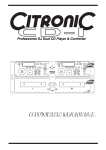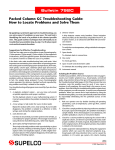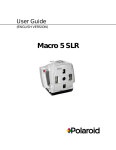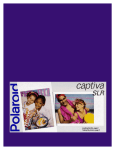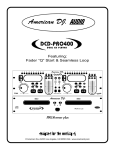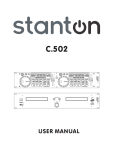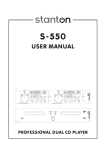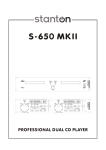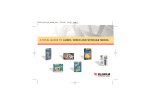Download American DJ DCD-PRO450 User manual
Transcript
FLIPFLOP Featuring: Sampling ÐDÐeÐsÐiÐgÐnÐeÐdÐ ÐfÐoÐrÐ ÐtÐhÐeÐ ÐwÐoÐrÐkÐiÐnÐgÐ ÐdÐj © American DJ® AUDIO Los Angeles, CA 90058 USA • www.americandj.com INTRODUCTION IMPORTANT SAFETY ITEMS FOR U.S.A. & CANADA MODEL ONLY WARNING: TO PREVENT FIRE OR SHOCK HAZARD, DO NOT EXPOSE THIS CD PLAYER TO WATER OR MOISTURE. CAUTION: 1. Handle the power supply cord carefully. Do not damage or deform; it may cause electric shock or malfunction when used. Hold plug attachment when removing from wall outlet. Do not pull on the cord. 2. To avoid electric shock, do not open the top cover when the unit is plugged in. If problems occur with the unit, call your local American DJ AUDIO dealer. 3. Do not place metal objects or spill liquid inside the CD player. Electric shock or malfunction may occur. Please record and retain the model name and serial number from your rating label. Model No.______________________________ Serial No.______________________________ CAUTION Do not open Risk of electric shock CAUTION: TO REDUCE THE RISK OF ELECTRIC SHOCK, DO NOT REMOVE THE COVER RACK. THERE ARE NO USER SERVICEABLE PARTS INSIDE. REFER SERVICE TO YOUR AUTHORIZED AMERICAN DJ AUDIO DEALER. The lightning flash with an arrow triangular symbol is intended to alert the user to the presence of uninsulated “dangerous voltage” within the products enclosure, and may be of sufficient magnitude to constitute a risk of electric shock. The exclamation point triangular symbol is intended to alert the user to the presence of important operating and maintenance (servicing) instructions in the user manual accompanying the CD player. NOTE: This CD player uses a semiconductor laser. It is recommended for use in a room at the following temperature: 41˚F - 95˚F / 5˚C - 35˚C CAUTION TO PREVENT ELECTRIC SHOCK DO NOT USE THIS (POLARIZED) PLUG WITH AN EXTENSION CORD, RECEPTACLE OR OTHER OUTLET UNLESS THE BLADES CAN BE CAREFULLY INSERTED TO PREVENT BLADE EXPOSURE. CAUTION: USE OF CONTROLS OR ADJUSTMENTS OTHER THAN THOSE SPECIFIED HEREIN MAY RESULT IN HAZARDOUS RADIATION EXPOSURE. THE COMPACT DISC PLAYER SHOULD NOT BE ADJUSTED OR REPAIRED BY ANYONE EXCEPT PROPERLY QUALIFIED SERVICE PERSONNEL. NOTE: This unit may cause interference to radio and television reception. Line Voltage Selection 115V (for multiple voltage model only) • The desired voltage may be set with 230V the VOLTAGE SELECTOR switch on the rear panel (using a screwdriver). • Do not twist the VOLTAGE SELECTOR switch with excessive force as this may cause damage. • If the VOLTAGE SELECTOR switch does not move smoothly, please contact a qualified service technician. VOLTAGE SELECTOR switch American DJ® AUDIO • DCD-PRO450™ INSTRUCTIONS MANUAL • PAGE 2 SAFETY INSTRUCTIONS I. Read Instructions - All the safety and operating instructions should be read before the appliance is operated. 2. Save Instructions - The safety and operating instructions should be saved for future reference. 3. Heed Warnings - All warnings on the appliance and in the operating instructions should be adhered to. 4. Follow Instructions - All operating and user instructions should be followed. 5. Water and Moisture - The appliance should not be used near water - for example, near a bath tub, washbowl, kitchen sink, laundry tub, in a wet basement or near a swimming pool, etc. 6. Ventilation - The appliance should be situated so that its location or position does not interfere with its proper ventilation. For example, the appliance should not be situated on a bed, sofa, rug, or similar surface that may block the ventilation openings; or, placed in a built-in installation, such as a bookcase or cabinet that may impede the flow of air through the ventilation openings. 7. Heat - The appliance should be situated away from heat sources such as radiators, heat registers, stoves, or other appliances (including amplifiers) that produce heat. 8. Power Sources - The appliance should be connected to a power supply only of the type described in the operating instructions or as marked on the appliance. 9. Grounding or Polarization - Precautions should be taken so that the grounding or polarization means of an appliance is not defeated. 10. Power-Cord Protection - Power-supply cords should be routed so that they are not likely to be walked on or pinched by items placed upon or against them, paying particular attention to cords at plugs, convenience receptacles, and the point where they exit from the appliance. 11. Cleaning - The appliance should be cleaned only as recommended by the manufacturer. 12. Non-use Periods - The power cord of the appliance should be unplugged from the outlet when left unused for a long period of time. 13. Object and Liquid Entry - Care should be taken so that objects do not fall and liquids are not spilled into the enclosure through openings. 14. Damage Requiring Service - The appliance should be serviced by qualified service personnel when: A. The power-supply cord or the plug has been damaged. B. Objects have fallen, or liquid has been spilled into the appliance. C. The appliance has been exposed to rain or water. D. The appliance does not appear to operate normally or exhibits a marked change in performance. E. The appliance has been dropped, or the enclosure damaged. 15. Servicing - The user should not attempt to service the appliance beyond that described in the operating instructions. All other servicing should be referred to qualified service personnel. American DJ® AUDIO • DCD-PRO450™ INSTRUCTIONS MANUAL • PAGE 3 GENERAL NOTES ON USE • Avoid high temperatures. Allow for sufficient heat dispersion when installed on a rack. • Handle the power cord carefully. • Hold the plug when unplugging the cord. • Keep the set free from moisture, water, and dust. • Unplug the power cord when not using the set for long periods of time. • Do not obstruct the ventilation holes. (For sets with ventilation holes.) • Do not let foreign objects in the set. • Do not let insecticides, benzene, and thinner come in contact with the set. • Never disassemble or modify the set in any way. MAIN FEATURES (1)8 times over sampling 1 bit D/A converter (2) Beat counter (3) Auto cue (4) 1/75th second frame search (5) Realtime cue (“Cue on the Fly”) (6) 6 different speed scan (7) Pitch display (8) REV/PLAY - Reverse play (9) 30 + 30 programmable tracks (10) Digital output RCA coaxial (11) Fader Start , Fader Stop , (back cue) Relay playback (using the control jack) and must use ADJ mixers (a) (12)Large bright LCD Screen can be viewed from wide angles. (13) (14) (15) (16) (17) (18) (19) (20) (21) (22) (23) (24) (25) 60 seconds transport protection (b) Seamless Loop CD-R and CD-RW compatible Flip-Flop, Relay Playback (c) +/- 8%, 12%, 16% on Pitch Slider Sleep Mode after 15 min. (d) Bop Effect (e) Jog Wheel Pitch Bend +/- 16% Memory Backup, Default to last setting (f) Instant Start “Q” Start Control (g) SKID effect (h) COAST effect (i) (a) FADER “Q” START: This function only operate in conjunctions with a compatible American DJ "Q" series mixer. (b) 60 SECOND TRANSPORT PROTECTION: Will automatically close transport if left open for more than 60 seconds to prevent someone from walking by and breaking the transport. (c) FLIP-FLOP: On the back of the control unit there are 2 inputs that say control use a standard mini plug (stereo), plug in from Side 1 to Side 2. Set both sides of the CD player to single mode on the control. Now when you play Disc 1 at the end of the last song the CD player will automatically change to Disc 2. Then when Disc 2 ends it will return to Disc 1, etc. (d) SLEEP MODE: The CD player automatically shuts off the transport and laser after 15 minutes (when in pause or cue mode). This will lengthen the life of your motor drive and laser. To restart player, just press cue or play buttons. (e) BOP EFFECT: A Bop Effect is a stutter, creating a sound similar to a CD skipping. (f) Memory Backup: This will automatically keep your last setting (repeat, SGL, CTN) even if you unplug AC current. It will also hold your cue points in memory if you accidentally open transport or shut off power. Memory cues are erased automatically when a new CD is played, or by holding memory button down for 3 -4 seconds. (g) “Q” Start Control: This feature is used with American DJ mixers featuring Fader “Q” Start. Connect the standard mini plugs, supplied, from Disc 1 output on CD player to the “A” player control input on the rear of mixer. Then connect the other supplied mini plug from Disc 2 output on CD player to the “B” player control input on the rear of mixer. By moving the mixer fader from left to right you can start and pause Disc 1 and Disc 2 respectively. In other words, when the cross-fader of the mixer is to the left, and you move it 20% to the right, Disc 2 will begin to play. When the cross-fader is to the right, and you move it 20% to the left, Disc 1 will begin to play. You can create great effects similar to scratching with this feature. After storing cue points on each side of the CD player, different songs or samples can quickly be recalled by moving the mixer cross-fader back and forth. New cue points can be easily selected on the CD player (1,19,20). “Q” Start control is easy to use and mastering this feature will help you create amazing effects with your music. (h) SKID Effects: This effect simulates the sudden platter stop of a turntable. Almost like pressing the stop button on a turntable. (i) Coast Effects: This effect will simulates turning the power off on a turntable - The platter spins until it slow loses momentum. American DJ® AUDIO • DCD-PRO450™ INSTRUCTIONS MANUAL • PAGE 4 PREPARATIONS 1. Checking the Contents Check that the carton contains the following items: 1) Main unit 2) Control unit 3) Operating instructions ( this booklet) 4) Two sets of RCA cables. 5) Two Control cords (6 feet / 1.8 meters) 2. Installing the Units Mount the units onto your console or rack with 19" EIA rack rails. CAUTION: • The player will work normally when the main unit is mounted with the front panel within 15 degrees of the vertical plane. If the unit is tilted excessively, discs may not be loaded or unloaded properly. (Figure 1) • The control panel's LCDs are designed to be clearly visible within the angles shown in Figure 2. Mount the control unit so that the visual angle is within this range. Fig. 1 Fig. 2 3. Connections 1) Turn off the POWER switch. 2) Connect the RCA pin cables to the inputs on your mixer. 3) Connect the control cables to the REMOTE connector on the main unit. CAUTION: Be sure to use the supplied control cables. Using another type of cable may result in damage. Be sure the power is off when connecting the control cables. Otherwise the units may not work properly. American DJ® AUDIO • DCD-PRO450™ INSTRUCTIONS MANUAL • PAGE 5 CONTROLS AND FUNCTIONS Front Panel: 1 2 4 3 18 19 5 20 6 21 7 22 8 23 9 11 10 12 14 13 15 16 17 Fig. 3 24 25 26 27 28 29 30 A. Remote unit front (figure 11) 1. SKID/COAST/ADJUST - This button allow you to change the SKID and COAST values. With the SKID/ COAST/ADJUST selected the SKID value is one second and the COAST value is five seconds. With the SKID/ COAST/ADJUST deselected (off) the SKID value is a 1/2 second and the COAST value is three seconds. 2. CUE MEMORY - This button allows you to program up to 4 cue points on the CD, first set a cue point (See Cue Section). Press the MEMORY Button (2) during play or pause, the memory LED lights up. Use frame search to reach desired point, then press a number button to memorize that starting point. Repeat above steps to memorize all 4 starting points if desired. 5. TIME BUTTON - The TIME button is used to changed the displayed time values. Time can be displayed as ELAPSED PLAYING TIME, track REMAINING TIME and TOTAL disc REMAINING TIME. 6. CUE BUTTONS - These button are used to store 4 user programmable "Cue Points." A "Cue Point" is a starting point anywhere on a disc. To program a "Cue Point" see Cue Points on page 10. 7. PROGRAM - This button is used to enter Program Mode. The word “PROGRAM” will be indicated in the display when Program Mode is activated. To program see "Programming" on page 11. 3. SKID BUTTON - This button activates the SKID effect. This effect simulates the sudden platter stop of a turntable. Almost like pressing the stop button on a turntable. When the SKID effect is selected a number 1 will appear in the LCD Display (13), this indicates SKID effect is selected. 8. REPEAT - This button allows you to select between REPEAT 1 or REPEAT ALL. Repeat 1 will continuous repeat the selected track. Repeat All will continuously repeat the disc. The repeat function will work in program mode, repeating a single track or repeating the entire program. 4. REV/PLAY BUTTON - This button activates reverse play mode. When this effect is selected the disc will begin to play in reverse mode, and continue to play in reverse until reverse play is turned off. If reverse play is not turned off the disc will continue to play in reverse until it returns to the beginning of the disc. When the REV/PLAY effect is selected a number 3 will appear in the LCD Display (13), this will indicate REV/PLAY is selected. 9. SGL/CTN - This function allows you to select single or continuous play. Single play will return a track to it's cue point when it has completed play. Continuous play will play the entire disc until the last track has completed play. 10. OPEN/CLOSE (Disc Tray Open/Close) - This button is used to load or eject the disc tray. Each press will open or close the disc transport tray. NOTE: The tray will not open unless the disc is in pause or cue mode. American DJ® AUDIO • DCD-PRO450™ INSTRUCTIONS MANUAL • PAGE 6 CONTROLS AND FUNCTIONS - REMOTE CONTROL UNIT (CONT.) 11. COAST BUTTON - This button activates the COAST effect. This effect will simulates turning the power off on a turntable - The platter spins until it slow loses momentum. When the COAST effect is selected a number 2 will appear in the LCD Display (13), this will indicates the COAST effect is selected. 12. P.S. BUTTON - This button changes the pitch value. The selectable pitch values are +/- 8%, +/-12%, +/-16%. These values immediately reflect the amount of pitch being applied to a music source in the CD drive. The pitch value is adjusted by sliding the PITCH SLIDER (23) up and down. 13. LCD DISPLAY - This high quality LCD indicates all the functions, as they are occurring, with the CD. The icons are explained in the next section. 14. BOP BUTTON - This button is used to activate the BOP Effect. A Bop Effect is a stutter, creating a sound similar to a CD skipping. The Bop Effect can be created in 2 ways. See creating a BOP on page 10. 15. (-) PITCH BEND Button - The pitch bend function allows the positioning of the bass beats to be matched. This button is used “fall back” to match the beats of another player. The pitch will drop while the (-) BUTTON is pressed (allowing “fall back”) and return to the original pitch when the button is released. By changing the pitch of one disc with respect to the other in this way the beats can be matched. 16. (+) PITCH BEND Button - The pitch bend function allows the positioning of the bass beats to be matched. This button is used to “catch up” to match the beats of another player. The pitch will rise while the (+) BUTTON is pressed (allowing “catch up”) and return to the original pitch when the button is released. By changing the pitch of one disc with respect to the other in this way the beats can be matched. 17. PITCH - This button activates the PITCH SLIDER (23). The Pitch LED will glow indicating pitch control is activated. 18. SHUTTLE WHEEL - (OUTER RING) This wheel has 6 forward and 6 reverse speed positions for searching through songs. The more you turn the wheel in either direction the faster you search through the music. 19. JOG WHEEL - (INNER RING) This jog wheel serves two functions depending on the mode you are working in. a. The jog wheel will act as a slow frame search control when the CD is not playing but either paused or set to a cue point. To set a new frame cue point, spin the wheel then press PLAY when you have determined the proper position. Press CUE to return to the “CUE POINT”. b. It also works as a pitch bend, when you turn clockwise the pitch will rise to 16%, and when you turn counterclockwise it will fall to -16%. 20. TRACK BUTTON - This button is used to back skip a track. Used to this function to go back to a desired track. 21. TRACK BUTTON - This button is used to forward skip to the next track. 22. +10 BUTTON - This button is used to quickly advance ten tracks. For example if you are on track two, pressing the +10 BUTTON will advance you to track 12. 23. PITCH SLIDER - The pitch slider changes the pitch percentage of the music source. The pitch values range from +/- 8%, +/- 12% or +/- 16%. Use the P.S. BUTTON (12) to change the selected pitch value. 24. BPM BUTTON - This button is used to switch between the BPM and PITCH values displayed in the LCD DISPLAY (40). 25. COUNTER BUTTON - When in BPM mode, tap this button to the beat of the music to determine the current Beats Per Minute (BPM). BPM will appear in the LCD DISPLAY (8, 33). 26. IN REALTIME BUTTON - (CUE “ON THE FLY”) This allows you to set a CUE POINT without stopping the play back. This button also sets the beginning of a seamless loop. To create a SEAMLESS LOOP see page 9. 27. CUE - Pressing the CUE BUTTON during play provides a return to the position at which play was started. If PAUSE is used before CUE or a new CUE POINT was set, that will now become the cue point. Alternately pressing the PLAY BUTTON (29) and the CUE BUTTON allows the CD to be played from the same position any number of times. The CUE LED will light up from the time the Cue button is pressed until the CD has reset to the position at which play was started. Steady lighting of this LED indicates the ready condition. The CUE BUTTON can be held down to play a CD. When you release the CUE BUTTON it instantly returns to the CUE POINT. You can also tap the CUE BUTTON to create a BOP EFFECT (for definition of BOP EFFECT, see page 5). 28. OUT/EXIT - Used to set the ending point when looping. When the OUT/EXIT BUTTON is pressed, the player will play the loop continuously. To exit the loop, press the OUT/EXIT BUTTON again. 29. PLAY/PAUSE BUTTON - Each press of the PLAY/ PAUSE BUTTON causes the operation to change from play to pause or from pause to play. 30. RELOOP BUTTON - If a SEAMLESS LOOP has been made, but the CD Player is not in SEAMLESS LOOP mode, press the RELOOP BUTTON (30) to reactivate the SEAMLESS LOOP mode. RELOOP (46) will appear in the LCD DISPLAY (13). To exit loop, press the OUT/EXIT BUTTON (28). American DJ® AUDIO • DCD-PRO450™ INSTRUCTIONS MANUAL • PAGE 7 CONTROLS AND FUNCTIONS - LCD DISPLAY 31 46 32 45 44 33 34 43 35 36 37 38 39 40 41 42 Fig. 4 B. LCD Display (figure 12) 31. SINGLE INDICATOR - This will indicate the player is in "SINGLE" play mode. 39. MINUTES INDICATOR - Detail the minutes elapse or remaining. 32. Function indicators - These indicators detail which effects or cue points are selected. 40. SECOND INDICATOR - Detail the seconds elapse or remaining. 33. CUE INDICATOR - This indicator details cue mode has been activated 41. Frame INDICATOR - Detail the frames elapse or remaining. 34. PLAY INDICATOR ( ) - The PLAY indicators will glow during normal playback. 42. PITCH OR BPM DISPLAY - Details either beat per minute or applied pitch percentage (see also 24 & 25). 35. PAUSE INDICATOR ( ) - The PAUSE indicators will glow during pause or cue mode. 43. BPM INDICATOR - Will glow when the BPM BUTTON (24) is engaged. This will also detail the value detailed in section 42 is in BPM's 36. TRACK INDICATOR - This will display the current track in play, pause, and cue mode or the current track being programmed in program mode. 37. PROGRAM INDICATOR - This indicator will glow when program mode is activate or program play has been activated. 38. REPEAT Indicator - (REPEAT 1, REPEAT ALL) The REPEAT indicator will detail complete disc repeat play. REPEAT 1 will indicate single track repeat play. 44. PITCH INDICATOR - Will glow when the PITCH BUTTON (25) is engaged. This will also detail the value detailed in section 42 is in pitch percentage. 45. ELAPSED, TOTAL, & REMAIN INDICATORS - These indicate that the time shown on the display is either in ELAPSED, TOTAL disc remaining, or SINGLE song remaining time. 46. LOOP, RELOOP - Appears when LOOP is engaged. LOOP will flashes when a loop is engaged. American DJ® AUDIO • DCD-PRO450™ INSTRUCTIONS MANUAL • PAGE 8 CONTROLS AND FUNCTIONS (REAR) 47 48 49 50 51 Fig. 5 C. MAIN UNIT REAR PANEL (Figure 5) 47. DIGITAL OUT - connect to Minidisc or CD-R device. before changing the voltage. 48. POWER CONNECTOR/FUSE - IEC Power Connector with built-in fuse holder. Always replace with same type fuse. 50. REMOTE 1 & 2 - Connect supplied 8-pin cable from REMOTE 1 on MAIN UNIT to REMOTE 1 on CONTROL UNIT (52). 49. VOLTAGE SELECTOR - Select which voltage desired: 115V or 230V. Always disconnect the power plug 51. AUDIO OUT 1 & 2 - Audio Out signals. Connect RCA cable from AUDIO OUT to a mixer input. 52 53 52 53 Fig. 6 D. CONTROL UNIT REAR PANEL (Figure 6) 52. CONNECT TO MAIN UNIT - Connect supplied 8-pin cable from REMOTE 1 on MAIN UNIT (50) to REMOTE 1 on CONTROL UNIT. 53. CONTROL - Connect mini-plug from CONTROL out on rear of CONTROL UNIT to a mixer’s CONTROL out. This feature is available on all mixers with Fader “Q” Start (see also “Q” Start Control p.5). American DJ® AUDIO • DCD-PRO450™ INSTRUCTIONS MANUAL • PAGE 9 BASIC OPERATIONS 1. OPENING AND CLOSING THE DISC TRAY AND LOADING DISCS • Press the OPEN/CLOSE BUTTON (10) to open or close the disc tray. OPEN/ CLOSE BUTTON (10) are provided on both the main unit and control unit or, press the PLAY/PAUSE BUTTON (29), to automatically close the transport tray and begin play. • If the transport tray is not closed after 60 seconds it will automatically close and enter pause mode.. • The disc trays cannot be opened during playback this is to prevent playback from accidently being interrupted. The tray can only be opened during pause or cue modes. 2. LOADING DISCS • Hold the disc by the edges and place it in the disc tray. Never touch the signal surface (the glossy side) of a disc. • When using 5 inch/12 cm discs, place the disc in the outer tray guides (Fig.7), and when using 3 inch/8 cm discs, place them securely in the inner guides (Fig.8). CAUTION: • DO NOT place any foreign objects in the disc tray, and do not place more than one disc in the disc tray at a time. Doing so may result in malfunction. • DO NOT push the disc tray in manually when the power is off, as this may result in malfunction and damage the player. 5 in. / 12cm disk Fig. 7 3 in. / 8cm disk 3. SELECTING TRACKS Fig. 8 • Tap the TRACK BUTTONS (20 & 21) once to move to one higher or lower track or hold the TRACK BUTTONS (20 & 21) down to change tracks continuously at a higher speed. • When a new track is selected during playback. Playback begins as soon as the search operation is completed. 4. STARTING PLAYBACK • Press the PLAY/PAUSE BUTTON (29) during the pause or cue to start playback. • The PLAY INDICATOR (34) will begin to when playback starts. • The point at which playback starts is automatically stored as a cue point. Pressing the CUE BUTTON (27) will return to this exact same point, until a new cue point is set. 5. STOPPING PLAYBACK • There are two ways to stop playback: 1) Press the PLAY/PAUSE BUTTON (29) during playback to pause at that point. 2) Press the CUE BUTTON (27) during playback to return to the position at which playback started. 6. PAUSING - The PAUSE indicator will glow when the unit is in pause mode. Pause mode is stopping the playback function at any point in a track, and resuming play at that exact same point. • Press the PLAY/PAUSE BUTTON (29) to switch between play and pause. 7. CUEING - When the unit is in cue mode the CUE INDICATOR (33) in the LCD (13) will glow. The CUE INDICATOR (33) will flash momentarily when a new cue point has been set. ”Cueing” is the action of preparing for playback. When the Cue button is pressed, playback returns to the cue point and enters pause mode. When the PLAY/PAUSE BUTTON (29) is pressed during the cue mode, playback starts. 8. CUE POINT SETTING - A beginning play point. Cue points are set in any of the four user programmable CUE POINT BUTTONS (6) or in the IN REALTIME CUE BUTTON (26). Be advised that the CUE BUTTON (27) and the in realtime CUE BUTTON (27) are linked together. Any cue point set in the IN REAL TIME CUE BUTTON (26) will automatically become the new cue point for the CUE BUTTON (27) and vice versa. To set a cue point: 1) Press the IN REALTIME CUE BUTTON (26) during playback to set the new cue point. 2) You may save 4 CUE points by pressing MEMORY, then set desired Cue, then press any of 4 CUE POINT BUTTONS (6). You can also set any of the 4 Cue points in realtime by pressing MEMORY during playback and then pressing any of the CUE POINT BUTTONS (6). • To return to a CUE POINT press the CUE BUTTON (27). This will return you to point as set in number 1 above. To return to the cue point set in CUE BUTTONS 6-9 (6), press the CUE BUTTONS 6-9 (6) that stores the cue point you wish to return to. If the unit is in playback mode the unit will immediately begin playback from that cue point. If the player is in pause or cue mode the unit will cue to that point. The LCD DISPLAY (13) will display the cue point selected, CUE POINTS 6-9 (32). American DJ® AUDIO • DCD-PRO450™ INSTRUCTIONS MANUAL • PAGE 10 BASIC OPERATIONS (CONT.) NOTE: When play starts via pause or track skipping or scanning, the CUE POINT will change to the start point automatically. 9. AUTO CUE - When a disc is loaded in to the unit, the cue point is set to the first source of music (The beginning of the first track). If a track is changed before pressing play, the CUE POINT is reset to your new starting point. 10. FRAME SEARCH - Frame search allows you to set a precise cue point. This accomplished in either cue or pause modes. While in pause or cue mode, use the inner jog wheel (19) to frame search. When you use the jog wheel the monitor function will allows you to here your frame search. Once you have set a new starting point press the PAUSE/PLAY BUTTON (29). Pressing play will set the new CUE point in memory. This new cue point can now be accessed at any time by pressing the CUE BUTTON (27). This cue point will stay set until you create a new cue point. 11. SCANNING (FAST FORWARD/FAST REVERSE) - Scanning works with the OUTER JOG WHEEL (18). This allows you to quickly scan through a disc or track. To do this rotate the outer Shuttle wheel in a clockwise or counter-clockwise direction. You can scan forward or reverse in 6 different speeds. The speed of your scan will depending on how much you rotate the wheel. 12. SEAMLESS LOOP PLAY - A loop is a section music that continuously play over and over. This unit allows you to create a seamless loop between two continuous points and replay loop seamless (without gaps or music interruption). When creating a seamless loop you must be in playback mode. To create a seamless loop: 1) Be sure you are in playback mode. The PLAY/PAUSE BUTTON’S (29) LED will be glowing (Fig.9). 2) When you reach a point in playback that you to create as your starting point. Fig. 9 Press the IN REAL TIME CUE BUTTON (26). This will set the starting point of your SEAMLESS LOOP. The IN REAL TIME CUE’S BUTTON LED (26) will begin to glow (Fig 10). 3) When you reach the point in playback that will be the ending point for your loop, Fig. 10 press OUT/EXIT BUTTON (28). Pressing the OUT/EXIT BUTTON (28) will set the ending point of your SEAMLESS LOOP. SEAMLESS LOOP mode will be indicated by the IN REALTIME CUE (26) and OUT/EXIT (28) LEDs flash repeatedly. The LOOP INDICATOR (44) in LCD DISPLAY (13) will also flash. 4) Sound will continue in seamless loop mode until you exit the loop or set a new cue point. Fig. 11 5) To exit the SEAMLESS LOOP, press OUT/EXIT BUTTON (28). LEDs will remains on but will stop flash. Music will resume normal play (Fig.12). The LED's remain on to indicate a loop is in memory and is ready to be recalled. 6) To replay loop, press the RELOOP BUTTON (30). The IN REALTIME CUE (26) and OUT/EXIT (28) LEDs will immediately begin flashing (Fig.13). The LOOP INDICATOR (44) in LCD DISPLAY (13) will also begin to flash. 13. EDITING A LOOP - This function allows you to set a new ending point for a loop you already created. Only the ending point of a loop can be edited. You must actively be in loop playback mode to edited to set a new loop ending point. 1) If a SEAMLESS LOOP has already been created, be sure your are in loop playback mode - Loop is running. 2) Next, press OUT/EXIT BUTTON (21) to return to normal play (figure 23). This will disengage the SEAMLESS LOOP mode. 3) When your reach the point of your desired new loop ending point (Fig.11). This set your new loop ending point into memory. FOR SHORTER LOOP: press OUT/EXIT BUTTON (28) quickly. FOR LONGER LOOP: Wait until the song plays several frames, them press OUT/EXIT BUTTON (28). Fig. 12 Fig. 13 14. TIME DISPLAY - The time display may be changed to read in three different options. Elapse track play, Track remaining play, total disc remaining. During normal play, each time you press the TIME BUTTON (5), the time value in the LCD DISPLAY (13) changes to give you the following information: 1) ELAPSED playing time (43). 2) REMAINing time of a track (43). If the current track number is over 34, “...................” is displayed. 3) TOTAL remaining time of the disc (43). American DJ® AUDIO • DCD-PRO450™ INSTRUCTIONS MANUAL • PAGE 11 BASIC OPERATIONS (CONT.) 15. REPEAT PLAYBACK - This function allows you to repeat one track or the entire disc. • Press the REPEAT BUTTON (8), the REPEAT 1 INDICATOR (37) will begin to glow, The player will continuously repeat the current track. • Press the REPEAT BUTTON (8) again, the REPEAT 1 indicator will turn off and just repeat will remaining on. The player will now repeat the entire disc. • Press the REPEAT BUTTON (8) again, to turn off the repeat function. 16. PITCH BENDING - This function will momentarily speed-up or slow-down the pitch percentage. • The pitch percentage will increases or decreases respectively when the PITCH BEND +(16) or PITCH BEND - (15) buttons are pressed. The extent to which the speed changes is proportionate to the amount of time the buttons are held down. For example, if the PITCH BEND + BUTTON (16) is held in continuously, the pitch will increases continuously until the button is released or until a maximum of 16% pitch is obtained.. • The INNER JOG WHEEL (19) will also temporarily act as a pitch bend, but only while in playback mode. Rotating the INNER JOG WHEEL (19) in a clockwise direction will bend the pitch in a positive manner while rotating the INNER JOG WHEEL (19) while in a counter-clockwise direction will bend the pitch in a negative manner. The speed that you rotate the INNER JOG WHEEL (19) will determines the amount of pitch percentage. 17. PROGRAM MODE/PLAY - This function allows you to program up to 30 tracks to be programmed and replayed in your desired order. To begin programming: 1) Press the PROGRAM BUTTON (7) to activate program mode. The PROGRAM INDICATOR (36) LED above the PROGRAM BUTTON (7) will begin to glow. The PROGRAM INDICATOR (36) in the LCD DISPLAY (13) will also turn to indicate program mode is active. 2) Select a track to program by using the F. SKIP AND B.SKIP BUTTONS (20 & 21). Once you have selected a track, press PROGRAM BUTTON (7) to lock this track into the programs memory. 3) Repeat step to up to 30 time. (ie. up to 30 tracks can be programmed). 4) After you have completed your programming you can review the tracks you entered into the program memory by tapping on the PROGRAM BUTTON (7). The LCD DISPLAY (13) will detail which tracks have been programmed. 5) Pressing the PAUSE/PLAY BUTTON (29) will begin your program playback. 6) To cancel your program press and hold down the PROGRAM BUTTON (7) for more than 2 seconds. 18. BOP FUNCTION - A Bop Effect is a stutter, creating a sound similar to a CD skipping. You can create a BOP effect in three ways by: 1) By Rapidly Pressing the CUE BUTTON (20) a. Be sure you are in playback mode. b. Rapidly press the CUE BUTTON (27) in sync with the music (Fig. 14). Fig. 14 2) By Rapidly Tapping on the BOP Button (14) a. Be sure you are in playback mode. b. Press the IN REALTIME CUE BUTTON (26) this will set a new cue point. (Fig. 15). c. Press MEMORY BUTTON (2) to set your CUE POINT in memory. The CUE BUTTON (27) LED will begin to glow (Fig 16). Fig. 15 d. Press the BOP BUTTON (14) this lock a new cue point in to the BOP Button (14) memory (Fig. 17). e. To access this BOP rapidly tap on the BOP Button (14) (Fig. 17). 3) By Rapidly Tapping on the CUE BUTTONS 6-9 (6) a. Be sure you are in playback mode. Fig. 16 b. Press the IN REALTIME CUE BUTTON (26) this will set a new cue point. (Fig. 15). c. Press MEMORY BUTTON (2) to set your CUE POINT in memory. The CUE BUTTON (27) LED will begin to glow (Fig 16). d. Press a CUE BUTTON 6-9 (6) this will lock a new cue point in to the memory of the CUE BUTTON 6-9 (6) you selected (Fig. 18). e. To access this BOP rapidly tap on the CUE BUTTON 6-9 (6) you selected (Fig. 18). Fig. 17 Fig. 18 American DJ® AUDIO • DCD-PRO450™ INSTRUCTIONS MANUAL • PAGE 12 MATCHING THE BEATS PER MINUTE (BPM) Beat matching is the act of line up the beats of two separate music source to blend them in to each senseless. This is functions that may take some practice. To properly beat match: 1) Find the BPM of the song playing by pressing the BPM BUTTON (24). Next, tap the COUNTER BUTTON (25) firmly to the beat of the music until a BPM COUNT (40) is displayed on the LCD DISPLAY (13). 2) Repeat step 1 for the song you want to mix in. You can listen in by cueing it in your headphones using your mixer or by following the BEAT LED located above BPM BUTTON (24) on the CD Player. 3) Engage Pitch by pressing PITCH (17) on the side you want to use, make sure Readout is in BPM by pressing BPM BUTTON (24) until BPM is lit on LCD DISPLAY (13). Adjust pitch until same BPM as original song is reached. 4) The by using your American DJ "Q" series mixer fade one music source in to the other. BEFORE SWITCHING OFF THE POWER • When you have finished using the CD player, and before switching off the power, be sure that the disc holder has been closed with the OPEN/CLOSE button (see figures 25 & 26). • TRAY PROTECTION: If tray is not closed after 60 seconds, it will close automatically and pause. CAUTION: DO NOT forcibly close the disc holder when the power is off. Fig. 26 Fig. 25 Switch off the power after the disc holder has been closed with the OPEN/CLOSE button. DO NOT switch off the power when the disc holder is open. CDS LEFT IN PLAYER - If a CD is left in the player and the remote has been disconnected, plug power cable in, turn on power and take out CD. COMPACT DISCS 1. PRECAUTIONS ON HANDLING COMPACT DISCS • Do not allow fingerprints, oil or dust to get on the surface of the disc. If the disc is dirty, wipe it off with a soft dry cloth. • Do not use benzene, thinner, water, record spray, electrostatic-proof chemicals, or siliconetreated cloths to clean discs. • Always handle discs carefully to prevent damageing the surface; in particular when removing a disc from its case • Do not bend the disc. • Do not apply heat. • Do not enlarge the hole in the center of the disc. • Do not write on the label (printed side) with a hardtipped implement such as a pencil or ball point pen. • Condensation will form if a disc is brought into a warm area from a colder one, such as outdoors in winter. Do not attempt to dry the disc with a hair dryer, etc. 2. PRECAUTION ON STORAGE • After playing a disc, always unload it from player. • Always store the compact disc in the jewel case, protecting from dirt or damage. • Do not place discs in the following areas: a) Areas exposed to direct sunlight for a considerable time. b) Areas subject to accumulation of dust or high humidity. c) Areas affected by heat from indoor heaters, etc. American DJ® AUDIO • DCD-PRO450™ INSTRUCTIONS MANUAL • PAGE 13 SPECIFICATIONS GENERAL Type: Disc type: Dimensions: Twin mechanism compact disc player with wired controller. Standard compact discs (5 in / 12cm and 3in/8cm discs) Player unit: 19" (W) x 3 15/32” (H) x 9 55/64” (D) 482mm (W) x 88mm (H) x 264mm (D) (without feet) Control unit: 19"(W) x 5 3/4” (H) x 1 37/64” (D) 482mm (W) x 132mm (H) x 74mm (D) (without feet) 19-inch rack mountable Player unit: 2U / 2 rack spaces Control unit: 3U / 3 rack spaces Player unit: 11 lbs. / 5 kgs Control unit: 4.5 lbs. / 2 kg 115/230V AC, 50/60Hz 25W Operational temperature: 5 to 35˚C (41 to 95˚F) Operational humidity: 25 to 85% (no condensation) Storage temperature: -20 to 60˚C (4 to 140˚F) Connecting cord (2 sets for left and right channels) Control cord (1.8m / 6 feet) Installation: Weight: Power supply: Power consumption: Environmental conditions: Accessories: AUDIO SECTION Quantization: 16 bit linear per channel Sampling rate: 44.1 kHz at normal pitch Over sampling rate: 8 times D/A conversion 16 bit Frequency response: +/- 1 dB 20 Hz to 20,000 KHz Total harmonic distortion:* 0.02% Signal to noise ratio:* 88 dB Channel separation:* 80 dB Output level: 2.0V +/- 1dB Load impedance: 47 kohm or more * with 20KHz low pass filter FUNCTIONS Variable pitch: +/-8%, +/-12% or +/-16% Search accuracy: 1/75 sec. (1 subcode frame) Specifications and design are subject to change without notice for purpose of improvement. American DJ® AUDIO World Headquarters: 4295 Charter Street Los Angeles, CA 90058 USA Tel: 323-582-2650 Fax: 323-582-2610 Web: www.americandj.com E-mail: [email protected] American DJ® AUDIO • DCD-PRO450™ INSTRUCTIONS MANUAL • PAGE 14














